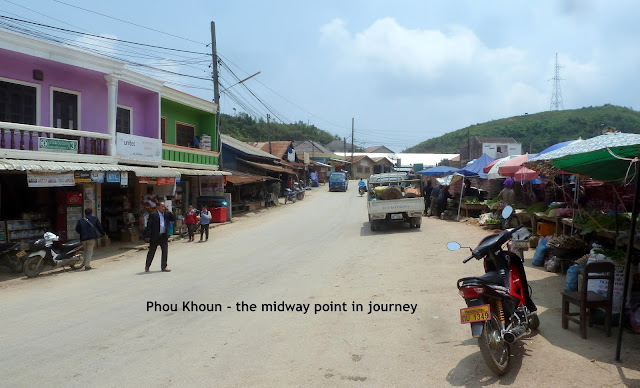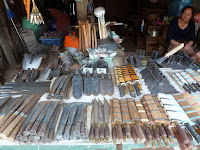What seems a lifetime ago, I had studied the
tribes inhabiting the regions of NE India, Burma and South East Asia. So, I was
looking forward to actually visiting the areas where the Hmong’s, the Kachin's
and other tribes lived today and more so in seeing once again at first hand the
fabulous textiles and crafts which I had studied at the Dept of Archaeology and
Anthropology in the late 1960’s. Laos is one of the most ethnically diverse
countries having 49 officially recognised tribal groups.

It was a surprise to me that TEAC – the Centre for
Traditional Arts and Ethnology – is actually run by some French ladies with Lao
support staff. It is dedicated to preserving and promoting the cultural
diversity of the country. Founded in 2006, it generates income from ticket sales,
donations and services.
TEAC activities include exhibitions, preservation
and documentation, education and outreach and finally, advocacy and livelihood
work. Very creditable objectives clearly established. Foreigners are also
welcome to attend certain workshops.
It is located in a small bungalow way up a small
hill and in a totally out of the way place. It consists of a museum and a small
shop where you get some excellent items at high prices, but having bought some
scarves and table hangings, well worth the price. This is a dying art and it’s
because of TEAC’s support of local weavers that one can appreciate them for
years.
TEAC gives back 50% of its income to the villages across Laos.
The museum display is well designed, the exhibits
well lit, the write ups perfect – in Lao and English – and it follows a well
laid out path in its layout. From clothes to house to jewellery etc.
There are four basic groups – The Tai-Kadai, The
Hmong-Yao, Sino-Tibetan and Austro-Asiatic.
I was just enamoured with the textiles on sale and found it really
difficult to choose.
Hmong embroidery is from the mountainous regions
of Laos, Vietnam, Myanmar and Thailand. During the Vietnam War, the Hmong’s
helped the American side and as a result thousands fled to USA when the USA
lost the war. Their embroidery and appliqué
techniques are famous for the detailed stitch work and amazingly intricate patterns.
It is said that their motifs are often inspired by nature or folklore.
The second group featured in TEAC was the Yao Mien
who is essentially from north Laos and are Taoists. Their women are dexterous
embroiderers who use three types of stitches – cross stitch, grid stitch and
weave stitch. This particular design would be featured on a man’s shirt or be
part of a design for a baby carrying cloth.
As the Yao use Chinese script as their written
language, there is a definite Chinese influence. Appliqué work and braided cord
are used as designs material for baby carriers – fabric used for strapping
babies on the back. Some important pieces may feature silver discs and the
craftswomen may take months to complete a design incorporating their
techniques.
I was told that one set of Yao Mien women’s trousers can take nine
months to embroider.
 A lesser known group are the Katu from south Laos and
highlands of central Vietnam having Austro-Asian background. This fabric is
woven on their traditional back strap loom and generally has cross thread or
weft beading.
A lesser known group are the Katu from south Laos and
highlands of central Vietnam having Austro-Asian background. This fabric is
woven on their traditional back strap loom and generally has cross thread or
weft beading.
Until the introduction of cheap machine made
textiles, traditionally every Hmong and other tribal household would have
produced its own textiles. Girls would learn the art of weaving, embroidery, appliqué,
indigo dyeing, and batik from a young age. Now women purchase batik cloth from
traders and then embellish with their own appliqué and embroidery. Polyester and cheap cotton have killed the
creative instincts and skills of the Lao women.



These Khmu women clothes are made from hand spun undyed cotton woven in their village of Luang Namth province. When they relocated, they left behind their looms and skills. The short exhibits a modern style decorated with sequins and multicoloured embroidery.

“Job’s tears” is a grass with long stems and
leaves resembling corn. Generally found in swamps or edges of a river. It grows
as a weed along roads also. They adapt well to natural and human habitat, they can
be easily gathered and cultivated. There are four wild species and three wild varieties
all native to this area.
They are used for three main purposes:
·
Food – domestic variety used as a cereal
– boiled or steamed as a meal or as a snack.
·
Medicine – herbal medicines are made
from their roots, stems, leaves and / or seeds.
Especially useful for skin and internal ailments.
·
Beads – locals gather the hard shelled
fruits from the wild species and use them as beads in handicraft items and
costumes.
Historically,
Job’s tears seeds were used for decorative purposes, based on the local environment
and an ability to cultivate certain seeds locally. Sadly plastic has started to
replace nature’s bounty. In the past natural materials played a crucial role:
plat vine, cotton, plant dyes and seeds. Now we have factory produced synthetic
fabrics, chemical dyes, plastic beads, and manufactured ornaments!!
As villagers get resettled, they have less access
to the forests and fields where they sourced their original needs. People now
have jobs and money so why waste time creating when they get a wider range of
items? Migration and media have exposed whole communities to different
lifestyles which led to changing livelihoods and cultural norms.

But why were bags decorated with Job’s tears? The seeds
were actually an item of decoration and beauty: the Wa of eastern Myanmar use
the tube shaped beeds.
But the Jhingpaw people of Kachin state in Myanmar
recognise the bag as a symbol of the male costume – for attending social and
cultural events. The bag symbolises the torso of a human and the tube shaped
seeds on the bottom fringe are the legs! However, in Yunnan province of China, Jhingpaw women
wear their bags with seeds to demonstrate their ethnic identity especially when
traditional clothes are not worn.
The Khmu are well known weavers – they would weave a traditional shape of bamboo basket according to which village they came from !! The visit to the TEAC museum was extremely interesting especially as they have done a splendid job in tracing and keeping alive the varied tribal cultures. A morning well spent.
Text and photographs copyright of the author. No part of this article or photographs maybe transmitted or reproduced by any means, electronic, mechanical, photocopying or otherwise, without written permission. Do contact the author on email -- helpthesun@gmail.com




























































